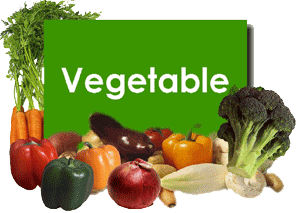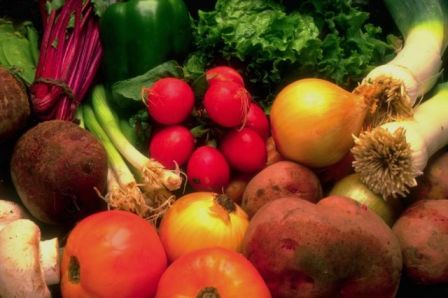
|
One food
item from this group is equal to:
|
|
2 gm Protein |
0 gm Fat |
5 gm Carbohydrate |
28 Calories |

Vegetables that contain small amounts of carbohydrates
and calories
are on this list. They also contain important nutrients.
Try to eat
at least 2 to 3 vegetable servings each day.
In general, one vegetable serving is:
½ cup of cooked vegetables or vegetable juice,
1 cup of raw vegetables |
Nutrition Facts.
- Fresh and frozen
vegetables have less added salt than canned
vegetables. Drain and rinse canned vegetables if
you want to remove some salt.
- Choose more dark green
and dark yellow vegetables, such as spinach,
broccoli, romaine, carrots, chilies, and
peppers.
- Broccoli, brussel
sprouts, cauliflower, greens, peppers, spinach,
and tomatoes are good sources of vitamin C.
- Vegetables contain 1 to 4
grams of fiber per serving.
|
Selection Tips.
- A 1-cup portion of
broccoli is a portion about the size of a light
bulb.
- Tomato sauce is different
from spaghetti sauce, which is on the
Bread/Starch list.
- Canned vegetables and
juices are available without added salt.
- If you eat more than 4
cups of raw vegetables, or 2 cups of cooked
vegetables at one meal, count them as 1
Bread/Starch serving.
- Starchy vegetable such as
corn, peas, winter squash, and potatoes that
contain larger amounts of calories and
carbohydrates are on the Bread/Starch list.
|
Artichoke
Artichoke hearts
Asparagus
Beans (green, wax, Italian)
Bean sprouts
Beets
Broccoli
Brussels sprouts
Cabbage
Carrots
Cauliflower
Celery
Cucumber
Eggplant
Greens (collard, kale, mustard, turnips)
Kohlrabi
Leeks
Mixed vegetables (without corn, peas, or pasta) |
Mushrooms
Okra
Onions
Pea Pods
Peppers (all varieties)
Radishes
Salad greens (endive, escarole, lettuce, romaine,
spinach)
Sauerkraut
Spinach
Summer squash
Tomato
Tomatoes, canned
Tomato sauce
Tomato/vegetable juice
Turnips
Water chestnuts
Watercress
Zucchini |
|



